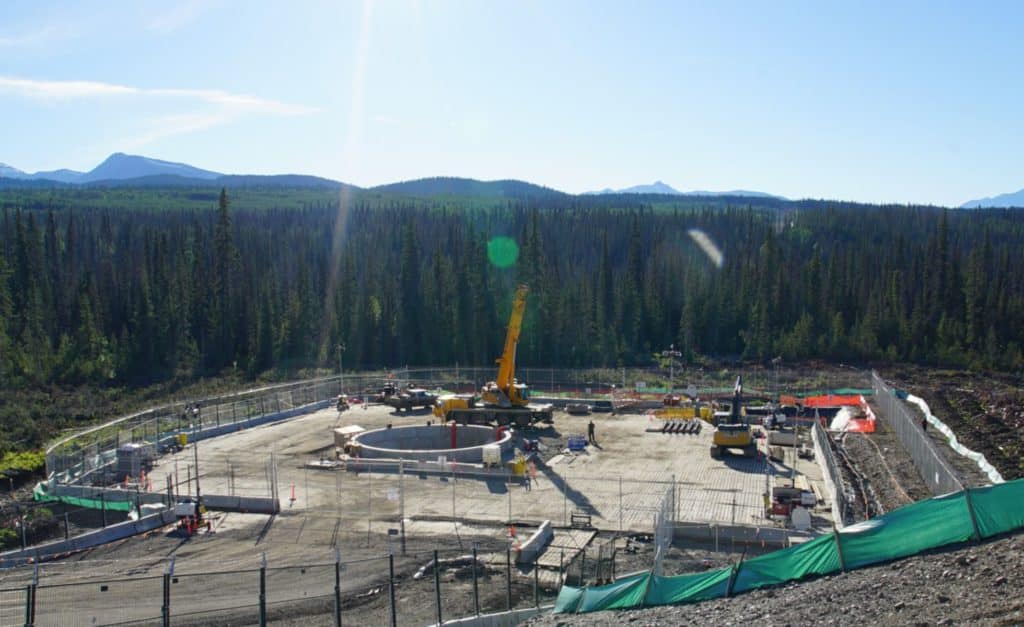
Drill pad site for under river LNG tunnel during Coastal GasLink pipeline construction. (Photo: Trevor Leach)
The science is clear. If we want a liveable planet for ourselves, future generations and countless other species, we cannot build any more fossil fuel projects anywhere. Not one. So that means saying no to liquified natural gas in British Columbia. Our governments know this. Premier Eby knows this (we’ll keep reminding him). The future is renewable energy. Let’s start building it now.
The cost of renewable energy has plummeted in recent years. No good argument supports any more fossil fuel development. No economic argument. No ecological argument. No ethical argument. Governments need to stop listening to oil and gas companies and focus on science and a bold, beautiful vision for the future.

1. A liveable planet
Leading experts on climate change and energy are united in saying we cannot develop any more fossil fuel projects if we want Earth to be habitable for humans. The International Energy Agency. The United Nations Environment Programme. The Intergovernmental Panel on Climate Change. They and the world’s wider scientific community are clear: A liveable planet can only be ensured via a rapid wind-down of the fossil fuel industry, no new fossil fuel projects and a wholesale transition to renewable energy.

2. Liquefied “natural” gas?
LNG isn’t “natural.” The fracked fossil gas that will be used to make it in British Columbia is harmful to public health. Fracked gas is produced by pumping toxic chemicals deep into the earth. Fracking leads to seismic destabilization and earthquakes.
Millions of litres of freshwater are made available to the oil and gas industry for fracking, essentially for free, and no treatment of industrial wastewater is required under current regulations.

3. Why does LNG love subsidies?
If LNG is such a good economic idea — as oil and gas companies and governments claim — why do some of the world’s biggest, most profitable oil and gas companies need billions of dollars in subsidies, preferential tax treatment and subsidized electricity to get the LNG industry off the ground in B.C.?
Part of the LNG marketing push by government and big oil and gas companies is about the revenue that could flow to government from LNG operations. But after the billions of dollars in subsidies and preferential financial treatments are factored in and with the likelihood that markets simply won’t be there by the time B.C. LNG is ready, there may be little to no revenue at all.

4. Not a “bridge” fuel or a climate solution
Oil and gas companies claim that LNG will act as a bridge fuel and displace coal in Asian markets. But that’s not necessarily the case. Building infrastructure to import and use it can crowd out investments in new renewables. It’s likely that LNG will be added to energy use in importing countries, leading to an overall increase in burning fossil fuels and climate pollution. Emissions from LNG — from the beginning of the supply chain to end use combustion — can be as damaging to the climate as coal.
Megaprojects such as LNG Canada in Kitimat and the Coastal GasLink pipeline being built through Wet’suwet’en traditional territory lock in emissions and lock up billions of dollars of investment, which could lock out the much-needed rapid transition to renewable energy.

5. Climate polluting every step of the way
LNG plants can run in two different ways. One uses electricity and the other uses fossil gas to power the industrial process. Some proponents of LNG talk about the benefits of electric drive, because it doesn’t create climate pollution from burning fossil gas — a clear admission that burning fossil gas creates climate pollution! Regardless of the industrial process used to manufacture LNG, it creates climate pollution when it’s burned for its end use.
LNG starts as fracked fossil gas and ends as burned fossil gas.

6. Police violence, colonialism and the Supreme Court
From coast to coast to coast, people in Canada have been outraged by the police violence against Indigenous land defenders as the Coastal GasLink pipeline is built through Wet’suwet’en traditional territory.
Even though the Supreme Court of Canada recognizes the right of Wet’suwet’en hereditary leaders to steward their territory, the pipeline has proceeded against their clearly stated wishes.
Even though the provincial and federal governments have made public commitments and limited progress in respecting the United Nations Declaration on the Rights of Indigenous People and the Declaration on the Rights of Indigenous Peoples Act, the RCMP’s Community-Industry Response Group has spent at least $25 million in a long-term tactical military deployment aimed at intimidation and criminalization of legitimate protest.

7. Pipelines are clearcuts that no one counts
One of the shocking things about the Coastal GasLink pipeline is that the 640-kilometre long clearcut being created for the pipeline corridor is not counted as part of British Columbia’s Annual Allowable Cut. Nor are the carbon emissions caused by the massive clearcut accounted for in the province’s emissions reporting regime.
So a clearcut as long as the road between Vancouver and Nelson isn’t counted and its emissions somehow don’t exist.

8. Stranded assets
Given the likelihood that BC LNG will be too late and too costly once it is ready for Asian markets– some massive pipelines and industrial facilities are likely to end up as stranded assets, or abandoned infrastructure, many of which will be on or impacting Indigenous territories.

9. All that electricity
LNG projects could end up using all of Site C’s electricity. That would make powering other key aspects of the emerging clean economy – like electric vehicles – much more challenging.
Is that really why Site C is being built? On some of the best agricultural land in the province at a time of intensifying food security concerns? So that oil and gas companies — some owned by governments of other countries, such as China, Malaysia and South Korea — can ship climate-polluting fossil fuels to their domestic markets?
Really?

10. Safety, marine habitat and tankers three football fields long
In the event LNG starts moving from the B.C. coast to distant markets, it will do so via some of the largest ships ever built — tankers three football fields long loaded with explosive, flammable gas.
Tankers will traverse sensitive marine habitat, posing a threat wherever they go, in inland waters and on open ocean.
No more LNG — B.C.’s big climate problem
While oil and gas companies make exorbitant profits, they want more and more of YOUR hard-earned cash in the form of subsidies and tax concessions so they can export fracked gas to Asia, where rosy projections of growing demand are fading while investment in renewable energy is soaring as costs plummet.
Premier Eby has the opportunity to do what’s best for us and the planet.
Please tell Premier Eby to say no to more LNG.

